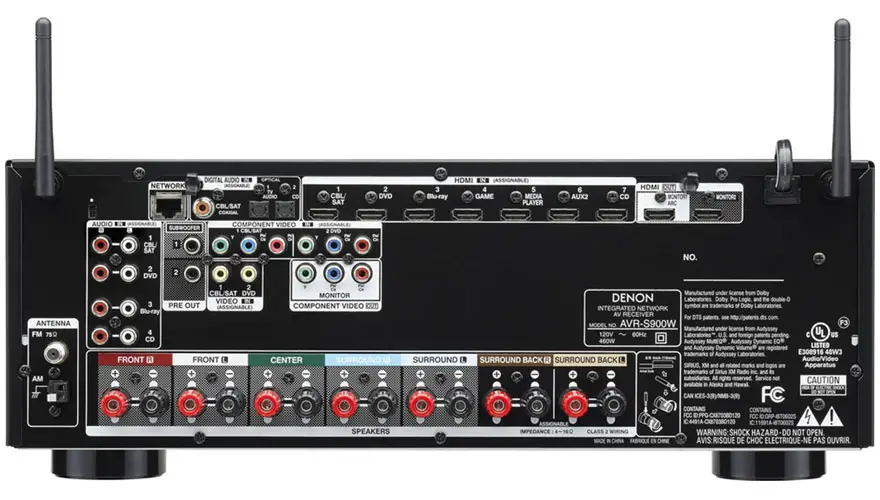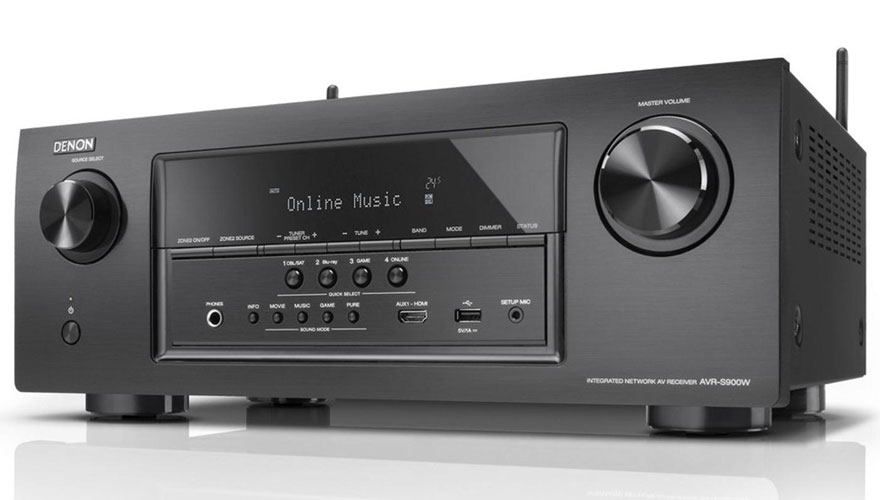Those looking at the Denon brand when buying a new home theater system is on the right track because Denon has a great selection of AV receivers. Denon’s 2014 AVR-X series cover most grounds from the movie enthusiasts to the audiophiles. $500 can already get you a highly capable 7.2-channel AV receiver known as the AVR-X1100W. But those that wish to go south of that price point will have to look at the less capable S-series. However, the top tier model of the AVR-S series, which is the Denon AVR-S900W, actually costs more than the AVR-X1100W. While it is quite a confusing move, it is welcome to see a receiver that is a cheaper than the AVR-X2100W and has a different set of strengths and weaknesses to attract buyers that might not like the X1100W.
Design
The Denon AVR-S900W, like the other AVR-S series, actually has a busier front panel design than the superior AVR-X series. For instance, the 4 Quick Select buttons are placed in their own row and appear as circular buttons. While the input select knob remains as a practical way to switch sources, the Quick Select buttons serve as a more economical way to change to the desired source and apply the proper audio profile. Just below these buttons is a set of smaller buttons that make it equally simple to change the audio profile on the fly no matter the active source. The available connection ports on the front are minimal but should suit most modern users as there is both an HDMI port and USB port to suit practically all mobile devices.
Heading to the back side, the Denon AVR-S900W looks quite similar to the pricier AVR-X2100W. You get the same number of HDMI ports – 7 inputs and 2 outputs. It is worth comparing to the AVR-X1100W as it only has 5 HDMI inputs and a single output making the AVR-S900W a clear choice if you want maximum HDMI connectivity for a cheap price. From the component video ports to the pre outs, things are practically identical but the Denon AVR-S900W lacks the necessary connection ports for custom installations.
Below is the back panel layout. Click on image to enlarge for a clearer view.
Features
The similarities between the AVR-S900W and the AVR-X series continue to the features where you get the same networking and wireless streaming experience. The built-in Wi-Fi is the best part because it allows today’s smartphones and tablets to connect to the receiver via a special mobile app. This app for Android and iOS provides a nice interface turning the mobile device into a remote control with a lot more functionality ranging from receiver configuration to actual music stream. iOS devices and other Mac computers can also use AirPlay to simplify the process of streaming iTunes music and playlists. Other devices outside of Apple can take advantage of the DLNA compliance. The Denon AVR-S900W also has limited access to the Internet as it can independently stream from Pandora, Spotify and SiriusXM radio stations.
The more basic mobile devices are not left out of the cold either as long as they at least have Bluetooth. The AVR-S900W has its built-in Bluetooth functionality and like the Wi-Fi capability, no extra dongle is required.
All of Denon’s 2014 receivers are designed to complement next-gen home theater systems that consist of 4K displays and 4K-ready components. This is all thanks to the support for HDMI 2.0 and it covers all the ports too. This specification also includes 21:9 video pass-through and 4:4:4 Pure Color, which should be something to appreciate when there is more mainstream Ultra HD content. Plus, the 2 HDMI outputs allow the receiver to handle a pair of displays on its own.
With the “Amp Assign” function, the Denon AVR-S900W may also be used to power a 5.1-channel home theater system in one room and a stereo system in another. Alternatively, you can use the extra channels as Front Height channels through the Dolby Pro Logic IIz decoder.
Performance
The AVR-S900W has a power output of 185 watts effectively matching the specs of the AVR-X2100W. But the AVR-X2100W comes with Audyssey Silver while the Denon AVR-S900W settles for the Bronze variant which has a more basic form of speaker calibration. It is still powered by Audyssey so you should get decent results out of a standard configuration but odd-shaped rooms could benefit from the Silver improvements.
Fortunately, the AVR-S900W doesn’t take stray too far away from the pricier X-series model as the S900W also supports upscaling of SD and HD content to 4K resolutions and the results look pretty good. This is a must-have feature for anyone with a huge movie collection that wishes to enjoy these titles on a 4K screen.
Bottom Line
After a thorough look at the Denon AVR-S900W it becomes a lot easier to see where this Denon receiver stands. Spec-wise, the receiver looks like it should belong in the X-series but it lacks custom integration and IP control. It is $100 cheaper than the AVR-X2100W because the room calibration features are more basic. It is also $100 more expensive than the AVR-X1100W thanks to the added HDMI ports and full 4K support complete with upscaling. Casual movie enthusiasts shouldn’t care so much about the custom installation so you should be able to get a lot more out of the features of this receiver for the money spent. With no superior version of this Denon AVR-S model, the AVR-S900W is a pretty good budget pick with plenty of power.
Update: There is a newer model > Denon AVR-S930H



